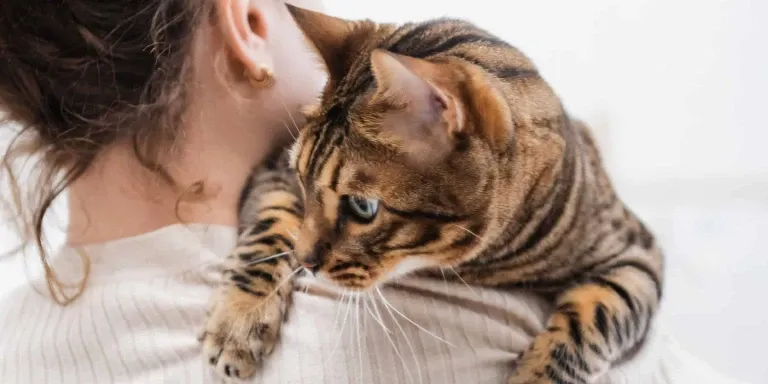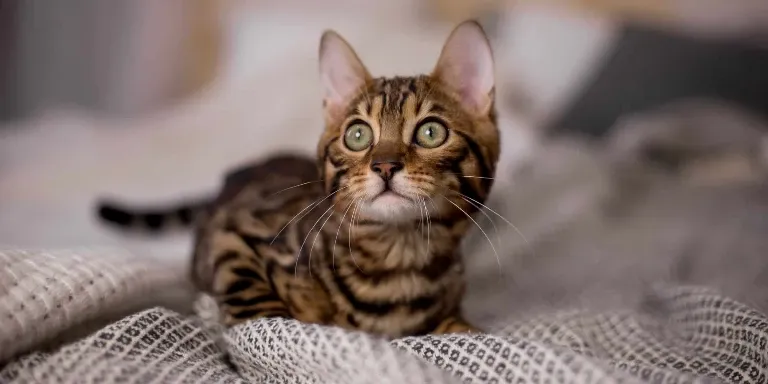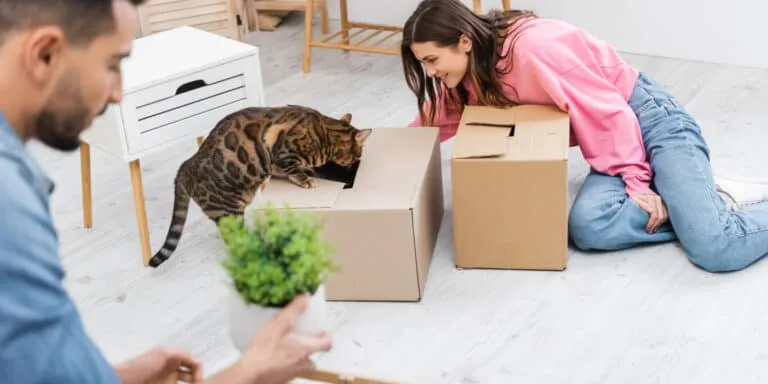The Best Fluffy Pancakes recipe you will fall in love with. Full of tips and tricks to help you make the best pancakes.

Are you the proud owner of a Bengal cat? If so, you have probably noticed that your feline friend can be quite vocal. From loud meows to intense purring, Bengal cats are known for their expressive nature. But have you ever wondered why they are so loud?
Bengal cats are known to be loud due to their genetic makeup. They are a cross between a domestic cat and an Asian leopard cat, which is a wild cat species. This hybridization has resulted in Bengal cats inheriting the vocalization traits of the Asian leopard cat, which are louder and more pronounced than those of domestic cats.
Additionally, Bengal cats are highly active and sociable, and they use their vocalizations to communicate with their owners and other animals.
In this article, we will explore the reasons behind Bengal cats’ vocalizations. We will discuss their communication methods, social nature, attention-seeking behavior, health issues, genetics, and breeding. By understanding these factors, you can better manage your Bengal cat’s vocalizations and maintain a happy and healthy relationship with your furry companion.
So let’s dive in and discover the secrets behind why Bengal cats are so loud!
An Overview of Bengal Cats
You’re probably wondering what makes Bengal cats such fascinating felines. Well, for starters, they’re a hybrid breed created by breeding an Asian leopard cat with a domestic cat. This unique combination results in cats that have strikingly beautiful coats with leopard-like spots or marbled patterns.
However, their temperament is what really sets them apart from other cats. Bengal cats are known for being highly active and energetic, making them a great choice for owners who are looking for a playful companion. They’re intelligent and curious, which means they need plenty of mental stimulation to keep them happy.
This can be achieved by providing them with interactive toys, puzzles, and plenty of opportunities to play and explore. When it comes to care requirements, Bengal cats need a high-quality diet, regular grooming to keep their coat looking its best, and plenty of exercise to keep them healthy and happy.
Overall, Bengal cats are a unique and fascinating breed that require a bit of extra care and attention, but they’ll reward their owners with endless love and entertainment.
Communication in Bengal Cats
It’s amazing how Bengal cats have mastered communication without speaking. Feline language is complex and includes nonverbal cues for conveying thoughts, feelings, and needs. Bengal cats are vocal and use different sounds to communicate. They meow for attention or food, purr when relaxed, or hiss when threatened.
In addition to vocalization, Bengal cats use body language to communicate. They arch their backs when frightened or angry, twitch their tails when curious, or flatten their ears when agitated. By interpreting these cues, owners can better understand their cats and provide for them.
Communication is essential for Bengal cats, and understanding their language can create a stronger bond with their owners. Learning to interpret nonverbal cues ensures that Bengal cats live happy and healthy lives.
Social Nature of Bengal Cats
With their playful and affectionate personalities, Bengal cats make wonderful companions who love to cuddle and spend time with their humans. These cats are known for their social nature and crave human interaction.
Here are some ways in which their playful energy and desire for human companionship manifest:
- Affectionate: Bengal cats are known for their love of physical affection and will often climb onto their owners’ laps for cuddles and pets.
- Playful: These cats have a lot of energy and love to play, whether it’s chasing toys, playing hide and seek, or simply running around the house.
- Vocal: Bengal cats are not only loud, but they’re also very vocal. They use a variety of sounds to communicate with their humans, from meows to trills to chirps.
If you’re looking for a cat that’s not only affectionate but also loves to play and interact with humans, then a Bengal cat may be the perfect choice for you. These cats thrive on human companionship and will keep you entertained with their playful energy and vocal nature.
Attention-Seeking Behavior
When seeking attention, Bengal cats may display various behaviors such as jumping onto your lap, rubbing against your legs, or vocalizing loudly. These cats are known for their attention-seeking behavior, which is why they’re often referred to as ‘talkative’ cats.
Bengal cats are highly intelligent, and they quickly learn that vocalizing loudly is an effective way to get your attention. They’re also very playful and energetic, so they need a lot of stimulus to keep them engaged.
To prevent excessive meowing and attention-seeking behavior in Bengal cats, it’s important to provide them with environmental enrichment. This means giving them plenty of toys, scratching posts, and interactive playtime.
Training methods such as positive reinforcement can also be used to teach Bengal cats appropriate behavior. For example, when your cat is quiet and calm, reward them with treats or praise. With consistent training and environmental enrichment, your Bengal cat can learn to be less vocal and more content with their surroundings.
Health Issues
Did you know that Bengal cats are prone to certain health issues that owners should be aware of? It’s important to dispel some common misconceptions about these felines and their health.
Here are three medical conditions that Bengal cats are more susceptible to:
- Hypertrophic Cardiomyopathy – This is a common heart condition that affects many cats, including Bengals. It’s important to have your Bengal screened for this condition as it can lead to heart failure.
- Flat Chested Kitten Syndrome – This is a condition that affects young Bengal kittens, where their chest does not develop properly. It can cause breathing difficulties and can be fatal if not treated promptly.
- Patellar Luxation – This is a condition where the kneecap dislocates from its normal position, causing pain and mobility issues. Bengals are more prone to this condition due to their active and athletic nature.
As a responsible Bengal cat owner, it’s important to stay informed about these health issues and take the necessary steps to prevent or treat them. Regular check-ups with a veterinarian and proper care can help your Bengal live a healthy and happy life.
Genetics and Breeding
When it comes to Bengal cats, genetics plays a significant role in their vocalizations. Breeding for specific traits, such as a loud and talkative personality, can result in cats that have a higher likelihood of being vocal.
Through selective breeding, breeders can create lines of cats that are more vocal than others.
Role of Genetics in Vocalizations
By understanding the role genetics plays in the vocalizations of Bengal cats, you can appreciate the complexity of their loud and unique meows. Inherited traits play a significant role in the variation of vocalizations among Bengal cats. These traits are passed down from one generation to the next through genes that dictate not only the physical characteristics of the cat but also its personality, including vocalization patterns.
One specific gene that’s been linked to vocalization in cats is the CatSper gene. This gene’s responsible for the development of sperm cells in male cats, but it’s also been found to play a role in the development of the vocal cords. Variations in the CatSper gene can lead to differences in the size and shape of the vocal cords, which can affect the pitch, tone, and volume of a cat’s meow.
Understanding the role of genetics in the vocalizations of Bengal cats can help breeders and owners appreciate the natural talents and unique characteristics of these fascinating felines.
The vocalizations of Bengal cats are a result of a complex interplay of inherited traits, including the CatSper gene. While there’s still much to learn about the genetics of vocalization in cats, understanding these factors can help breeders and owners appreciate the unique and special qualities of these beloved pets.
So the next time your Bengal cat lets out a loud meow, remember that it’s the result of a complex genetic process that makes them so special.
Breeding for Specific Traits
If you want to ensure that your furry friend has a particular temperament or physical trait, breeding for specific characteristics can be a tempting option. This is exactly what some breeders have done when it comes to Bengal cats and their vocalizations. Some breeders have selectively bred cats that are more vocal than others, resulting in a breed that is known for its loud and chatty nature.
However, breeding for specific traits can have negative consequences for genetic diversity. When a breeder focuses on a specific trait, they may unintentionally limit the gene pool from which they select. This can result in a higher likelihood of genetic disorders and health issues.
In addition, breeding for vocalizations can lead to cats with excessive meowing, which may become a nuisance for their owners. It’s important for breeders to consider the long-term effects of their breeding practices and prioritize the health and well-being of their cats.
Managing Bengal Cat Vocalizations
To handle your chatty Bengal cat, try teaching them to use a scratching post to communicate instead of constantly meowing up a storm. This is because Bengal cats are naturally vocal and love to communicate with their owners. However, excessive meowing can be a sign of boredom or anxiety, and providing them with a designated communication spot can help redirect their energy and provide them with a sense of control over their environment.
Training techniques can also be used to manage Bengal cat vocalizations. Positive reinforcement can be used to train them to meow at appropriate times, such as when they need food or attention. Environmental enrichment can also help reduce excessive meowing by providing them with stimulating toys and activities.
Providing them with a variety of toys, such as puzzle feeders, can help keep them mentally engaged and reduce boredom. By using these techniques, you can help manage your Bengal cat’s vocalizations while still allowing them to express themselves in a healthy way.
Do Bengal Cats Have Different Vocalization Patterns Compared to Other Cats?
Yes, Bengal cats versus standard cats do have different vocalization patterns. Bengal cats are known for their unique and varied vocalizations, including chirping and trilling. They are often more talkative and expressive compared to other cats. This makes them stand out in the feline world.
Conclusion
So, why are Bengal cats so loud? It’s not a straightforward answer. Genetics and breeding play a role, but a Bengal cat’s social and attention-seeking nature also contributes. Additionally, certain health issues can make them more vocal.
However, not all Bengal cats are loud, and some only vocalize occasionally. It’s important to remember that vocalizations can be a sign of communication and should not be ignored.
Overall, understanding their communication patterns and needs can help owners manage their vocalizations and create a happy and healthy relationship with their furry friend.








